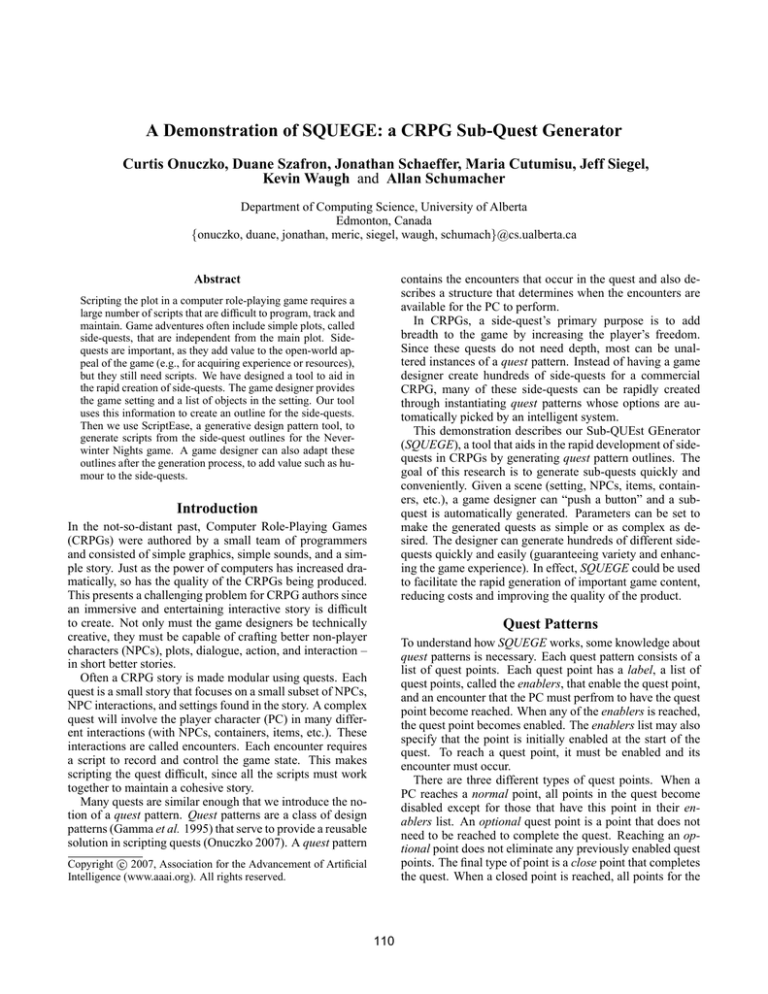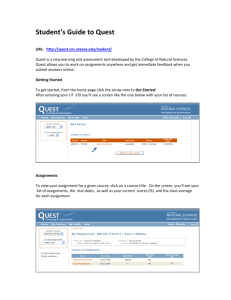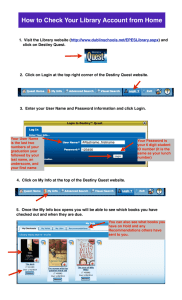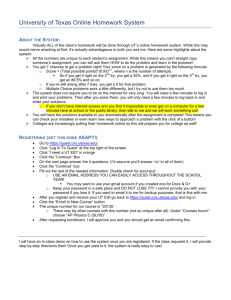
A Demonstration of SQUEGE: a CRPG Sub-Quest Generator
Curtis Onuczko, Duane Szafron, Jonathan Schaeffer, Maria Cutumisu, Jeff Siegel,
Kevin Waugh and Allan Schumacher
Department of Computing Science, University of Alberta
Edmonton, Canada
{onuczko, duane, jonathan, meric, siegel, waugh, schumach}@cs.ualberta.ca
Abstract
contains the encounters that occur in the quest and also describes a structure that determines when the encounters are
available for the PC to perform.
In CRPGs, a side-quest’s primary purpose is to add
breadth to the game by increasing the player’s freedom.
Since these quests do not need depth, most can be unaltered instances of a quest pattern. Instead of having a game
designer create hundreds of side-quests for a commercial
CRPG, many of these side-quests can be rapidly created
through instantiating quest patterns whose options are automatically picked by an intelligent system.
This demonstration describes our Sub-QUEst GEnerator
(SQUEGE), a tool that aids in the rapid development of sidequests in CRPGs by generating quest pattern outlines. The
goal of this research is to generate sub-quests quickly and
conveniently. Given a scene (setting, NPCs, items, containers, etc.), a game designer can “push a button” and a subquest is automatically generated. Parameters can be set to
make the generated quests as simple or as complex as desired. The designer can generate hundreds of different sidequests quickly and easily (guaranteeing variety and enhancing the game experience). In effect, SQUEGE could be used
to facilitate the rapid generation of important game content,
reducing costs and improving the quality of the product.
Scripting the plot in a computer role-playing game requires a
large number of scripts that are difficult to program, track and
maintain. Game adventures often include simple plots, called
side-quests, that are independent from the main plot. Sidequests are important, as they add value to the open-world appeal of the game (e.g., for acquiring experience or resources),
but they still need scripts. We have designed a tool to aid in
the rapid creation of side-quests. The game designer provides
the game setting and a list of objects in the setting. Our tool
uses this information to create an outline for the side-quests.
Then we use ScriptEase, a generative design pattern tool, to
generate scripts from the side-quest outlines for the Neverwinter Nights game. A game designer can also adapt these
outlines after the generation process, to add value such as humour to the side-quests.
Introduction
In the not-so-distant past, Computer Role-Playing Games
(CRPGs) were authored by a small team of programmers
and consisted of simple graphics, simple sounds, and a simple story. Just as the power of computers has increased dramatically, so has the quality of the CRPGs being produced.
This presents a challenging problem for CRPG authors since
an immersive and entertaining interactive story is difficult
to create. Not only must the game designers be technically
creative, they must be capable of crafting better non-player
characters (NPCs), plots, dialogue, action, and interaction –
in short better stories.
Often a CRPG story is made modular using quests. Each
quest is a small story that focuses on a small subset of NPCs,
NPC interactions, and settings found in the story. A complex
quest will involve the player character (PC) in many different interactions (with NPCs, containers, items, etc.). These
interactions are called encounters. Each encounter requires
a script to record and control the game state. This makes
scripting the quest difficult, since all the scripts must work
together to maintain a cohesive story.
Many quests are similar enough that we introduce the notion of a quest pattern. Quest patterns are a class of design
patterns (Gamma et al. 1995) that serve to provide a reusable
solution in scripting quests (Onuczko 2007). A quest pattern
Quest Patterns
To understand how SQUEGE works, some knowledge about
quest patterns is necessary. Each quest pattern consists of a
list of quest points. Each quest point has a label, a list of
quest points, called the enablers, that enable the quest point,
and an encounter that the PC must perfrom to have the quest
point become reached. When any of the enablers is reached,
the quest point becomes enabled. The enablers list may also
specify that the point is initially enabled at the start of the
quest. To reach a quest point, it must be enabled and its
encounter must occur.
There are three different types of quest points. When a
PC reaches a normal point, all points in the quest become
disabled except for those that have this point in their enablers list. An optional quest point is a point that does not
need to be reached to complete the quest. Reaching an optional point does not eliminate any previously enabled quest
points. The final type of point is a close point that completes
the quest. When a closed point is reached, all points for the
c 2007, Association for the Advancement of Artificial
Copyright Intelligence (www.aaai.org). All rights reserved.
110
Figure 1: A sub-quest outline generated by SQUEGE.
cific story-related references to make the conversations interesting and unique.
The author uses the outline to instantiate the corresponding quest pattern in ScriptEase. The process is straightforward as the author only specifies the options for the pattern.
Now the author has the opportunity to adapt the side-quest
instance in ScriptEase to add a creative touch to the story.
One of these adaptations could be to have a bandit NPC
appear and attack the PC when the item is acquired. Such
adaptations are quick and easy to do in ScriptEase.
At this point, the game designer has finished generating a
side-quest and can now play the adventure in NWN. If the
process is repeated, the designer would end up with a completely different side-quest using different NPCs, containers,
and items in the same setting.
quest become disabled and no new points can become enabled.
Quest patterns are specific enough that creating the scripts
for them is a straightforward process. Each quest point
needs one script. The associated encounter describes which
event will trigger the script, while the enabling points and
type of quest point determine how the script alters the game
state of the quest. When using a generative design pattern
tool, such as ScriptEase (McNaughton et al. 2004), the
scripting process becomes automated.
Using SQUEGE
To show how SQUEGE works we give an example that generates a quest in Neverwinter Nights (NWN) by Bioware
Corp. While this example only shows the generation of
one simple quest, SQUEGE can be used to generate multiple quests of arbitrary complexity within the same CRPG
adventure.
First, a game designer creates a new game adventure using
the NWN Aurora Toolset, a CAD tool for the game. The
author creates a city setting with several buildings that the
PC can enter. The author then prepares the game adventure
for quest generation by creating several NPCs, containers,
and items that will populate the game.
SQUEGE is currently external to the Aurora Toolset so
the game designer must list all the NPCs, containers, and
items that can be used in the side-quest. Next, SQUEGE automatically generates a side-quest by first selecting a quest
pattern from its catalogue of patterns. SQUEGE instantiates
values for the various options of the quest pattern and produces a graph that acts as an outline for the quest instance.
This outline contains all the information required to produce
scripts for the side-quest.
Figure 1 shows the graph that SQUEGE generates for the
game designer. This retrieve/deliver an item side-quest instance has the PC performing four encounters: beginning
the quest by talking to Emmel, finding the location of the
item by talking to Fistoon, acquiring the item in a shop crate
container, and returning the item by talking to Emmel again.
The triangle represents the start of the side-quest and it enables the first quest point in which the quest is given to the
PC.
The game designer creates the conversations for Emmel
and Fistoon in the Aurora Toolset. SQUEGE does not attempt to do this, as writing dialogue is one of the game designer’s specialties. The author may add humour and spe-
Demonstration
This demonstration showcases the entire side-quest generation process of SQUEGE for NWN. First, the demonstrator
creates a game setting in the Aurora toolset. Then, SQUEGE
generates a sub-quest outline from its pattern catalogue. The
conversations required for the sub-quest are created in Aurora. Next, a pattern for the sub-quest outline is instantiated
in ScriptEase. Finally, the sub-quest is played in NWN.
References
Gamma, E.; Helm, R.; Johnson, R.; and Vlissides, J. 1995.
Design Patterns. Elements of Reusable Object-Oriented
Software. Addison-Wesley.
McNaughton, M.; Cutumisu, M.; Szafron, D.; Schaeffer,
J.; Redford, J.; and Parker, D. 2004. ScriptEase: Generative Design Patterns for Computer Role-Playing Games. In
Automated Software Engineering, 88–99.
Onuczko, C. 2007. Quest Patterns in Computer RolePlaying Games. Master’s thesis, University of Alberta, Edmonton, Alberta, Canada.
111








